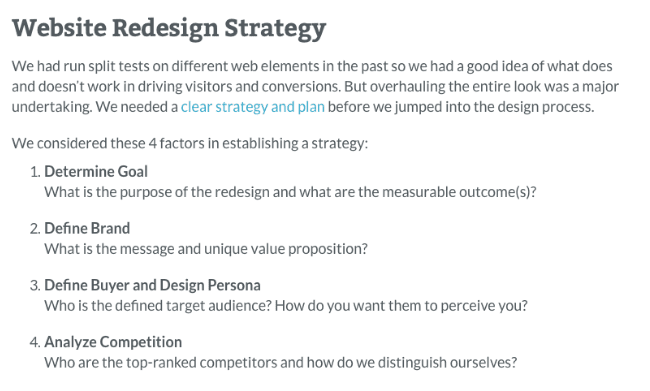This blog post is part of “The Ultimate Guide to Web Development” blog series.
What’s the most important part of creating a new website? Some might say SEO. Others might say mobile friendliness. There’s also responsive design, user experience and calls to action to consider.
None of these is most important, however. They are all tactics.
The most important part of creating a new website is strategy.
SurveyGizmo developed a new site that increased conversions by 31 percent. Where did they start? “We needed a clear strategy and plan before we jumped into the design process,” said Sandy McKee.
Guavabox answers its own rhetorical question, “Is a Website Design Strategy Important?” “You’re darn right it is important! Would you start building a submarine without a blueprint? Would you start playing rugby before knowing the rules of the game? Would you set out on a treasure hunt in the jungle without Blackbeard’s map?”
As George Harrison said, “If you don’t know where you’re going, any road will take you there.”

Companies come to us and ask if we can help them with a new website. Sure, we say, what do you want your website to do? “It’s really old,” they might say. “It’s out of date”–essentially the same message. They don’t really have any clear goals or strategy to achieve. Somehow they think that a new website will help their businesses just by being new.
You have to start with goals and a strategy to achieve them. The goals and strategies will differ for different types of businesses. An ecommerce business will have a different strategy than a long sales cycle B2B business. A consumer brand will have a different strategy than a manufacturing company. In its simplest form, a strategy includes goals, how you are going to reach them, and how you are going to measure success. Here’s how SurveyGizmo outlined its website redesign strategy.
 Of course, you also have to know where you’re starting. Many companies still don’t have simple metric measurement tools in place that track visits, referrals, and page views. If you don’t know what is happening on your site now, how can you hope to make your next one better?
Of course, you also have to know where you’re starting. Many companies still don’t have simple metric measurement tools in place that track visits, referrals, and page views. If you don’t know what is happening on your site now, how can you hope to make your next one better?
A 2015 survey by analytics expert Logit found that that up to 46 percent of B2B companies didn’t have Google Analytics installed on their website. Another survey from 2016 that included 1500+ B2B exhibitors at international trade shows found that up to 47 percent didn’t have Google Analytics installed.
In order to have meaningful goals, you have to know where you’re starting. Your first step might be to install Google Analytics on your old site and wait a few months before starting a redesign. Then at least you’ll have some awareness of how many people are visiting and what they are doing when they visit. You might even want to do some testing of different types of content.
A website without a strategy will likely fail to make a difference. Too many companies think that building a new website will improve traffic. There is a tiny bit of truth to this if the old site is not mobile friendly and being penalized by Google as a result. But other than that, newness alone does not improve website traffic, conversions, brand awareness, or sales. About the same number of people will continue to visit it.
Your website also needs to be integrated with the rest of your marketing strategy. You need to clearly define your target audience, how you will drive or attract them to your site, and what you want them to do when they get there. Digital advertising, PR, social networking, trade shows and all your marketing channels should work with your website to grow traffic, leads, and sales.
This blog post is part of “The Ultimate Guide to Web Development” blog series.




